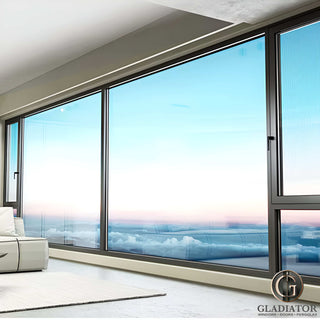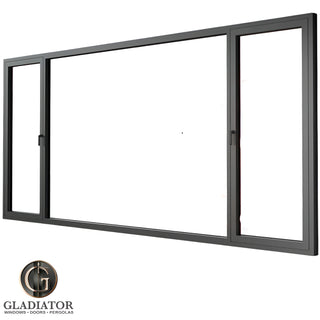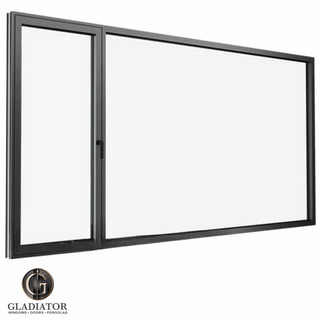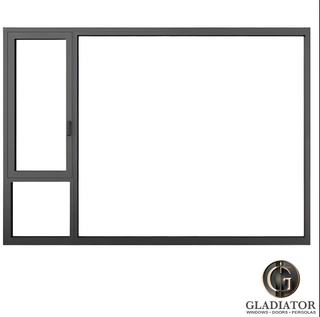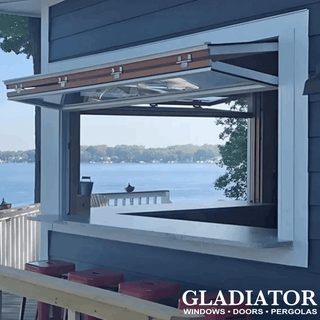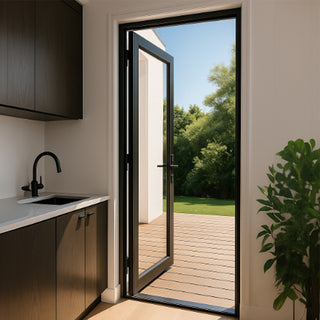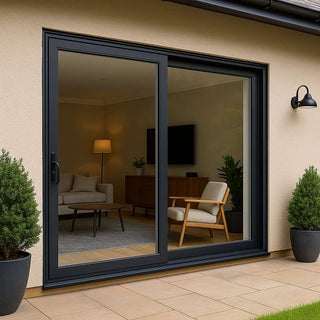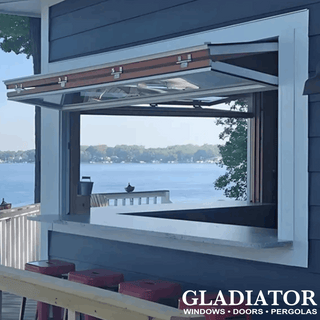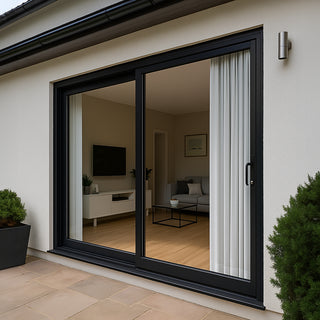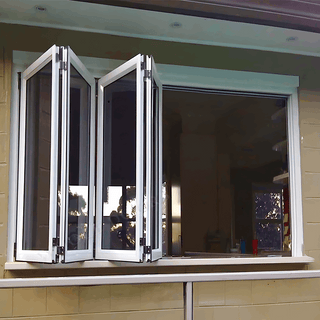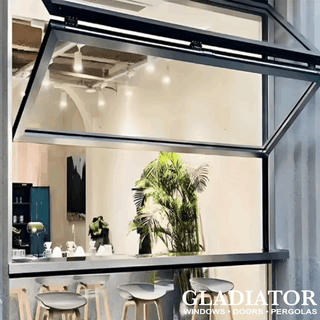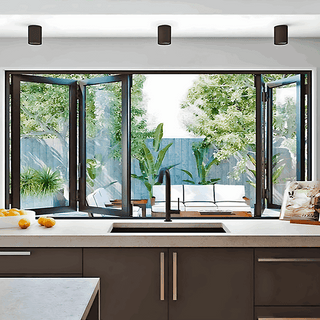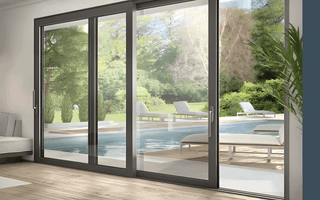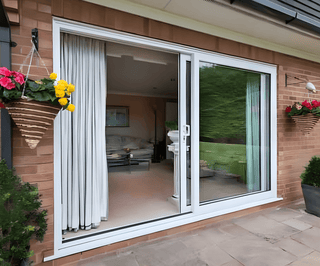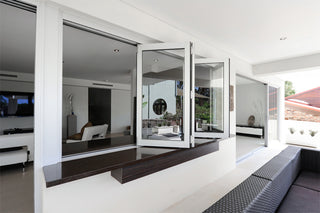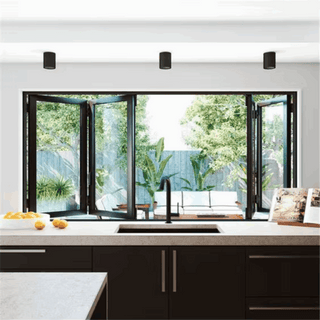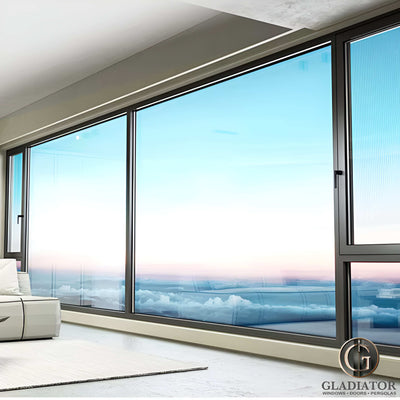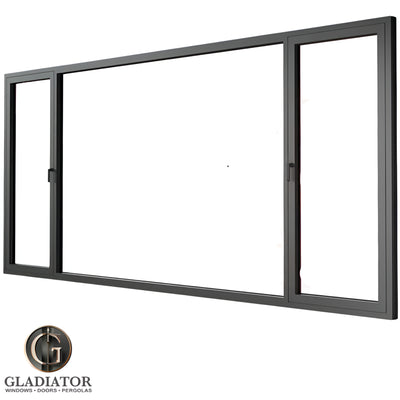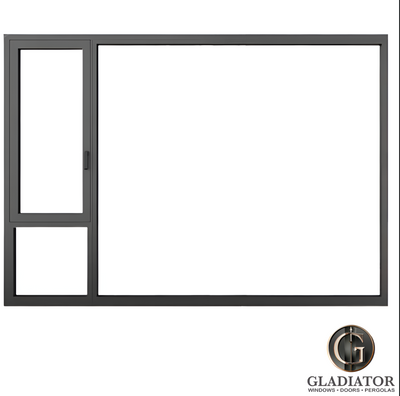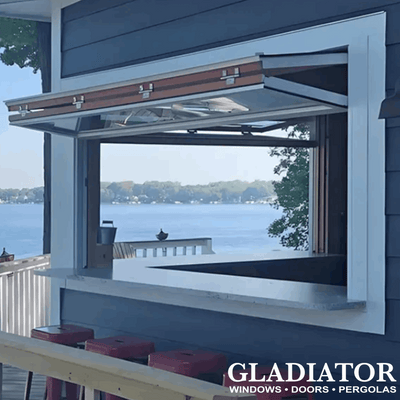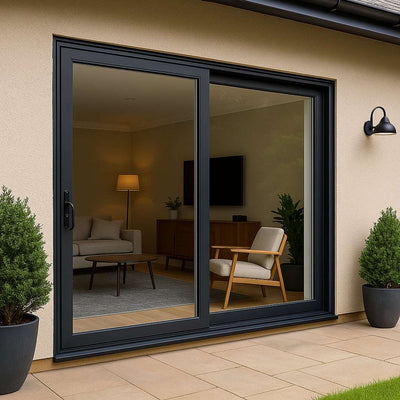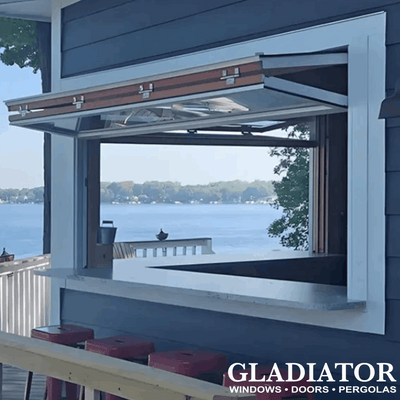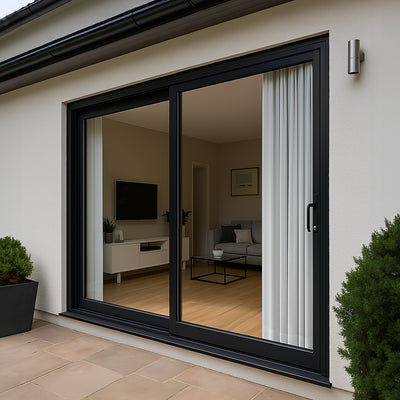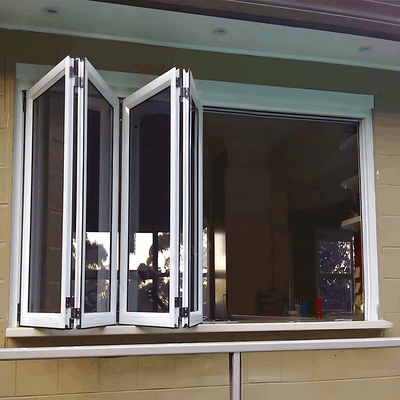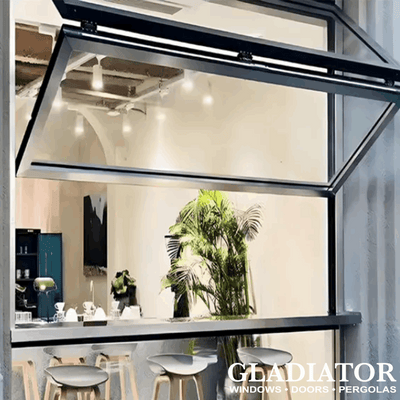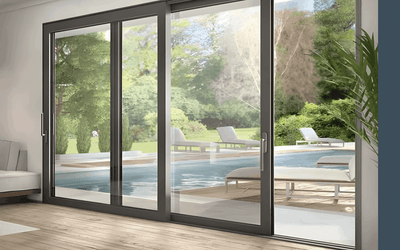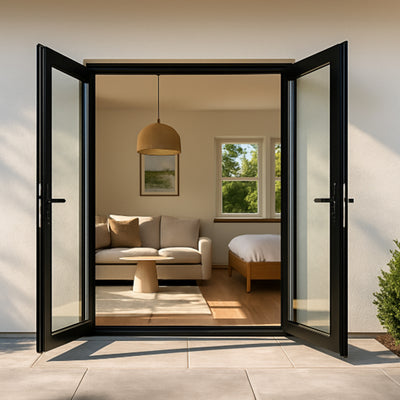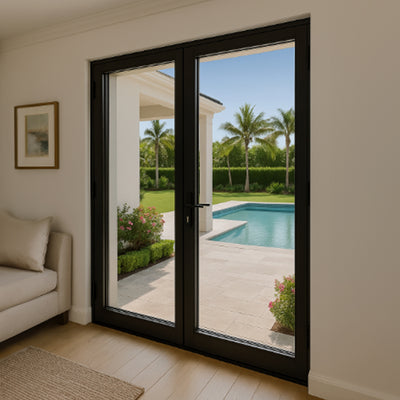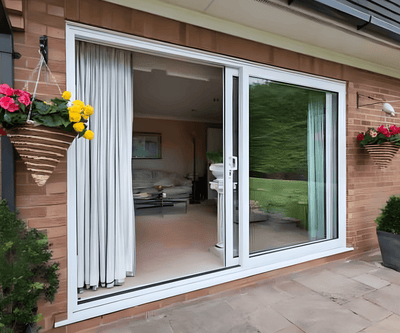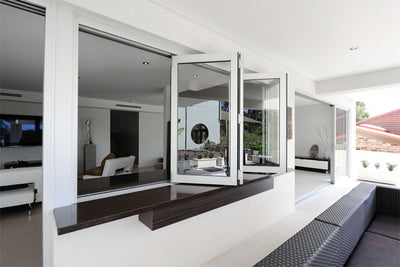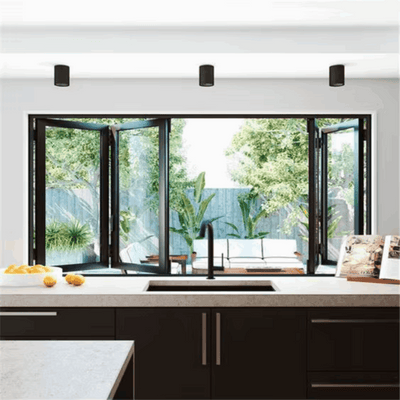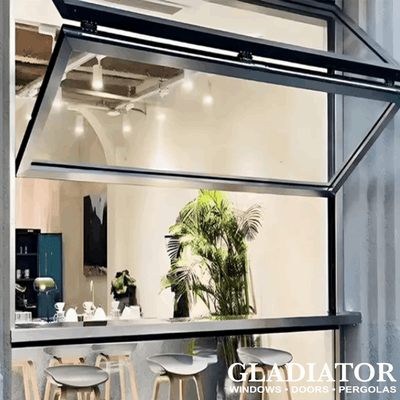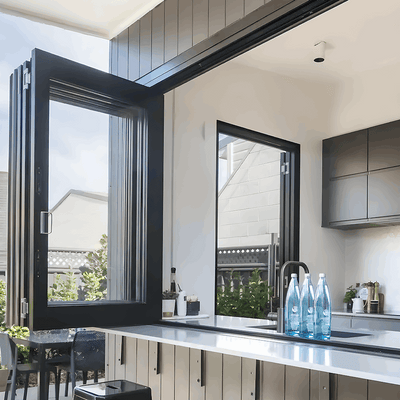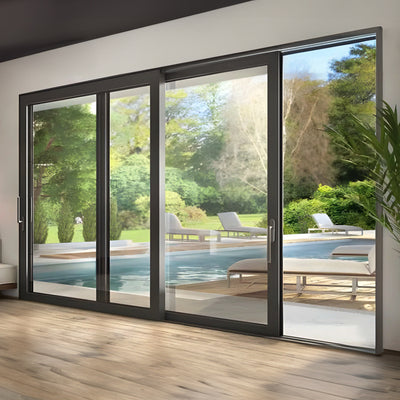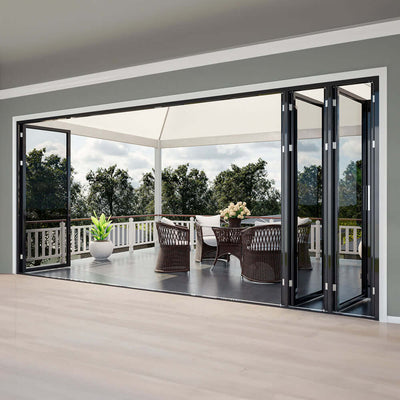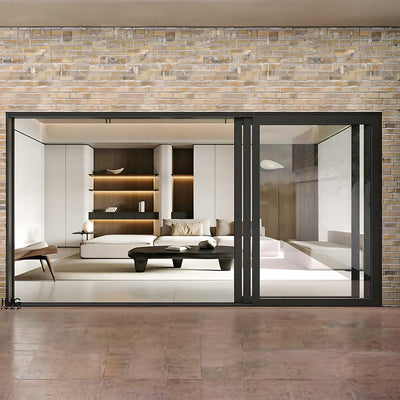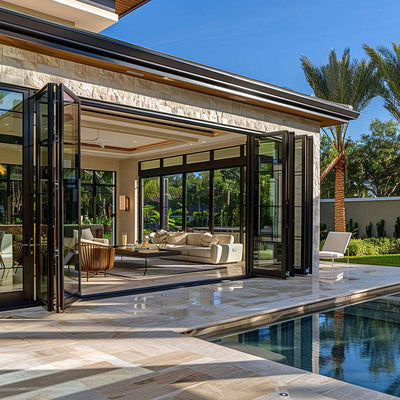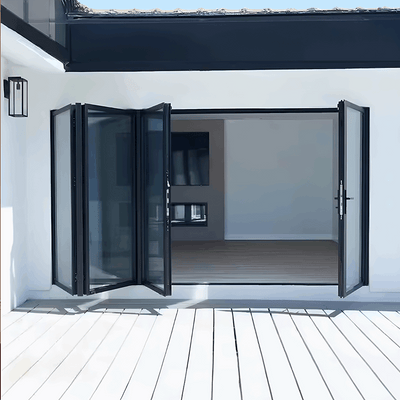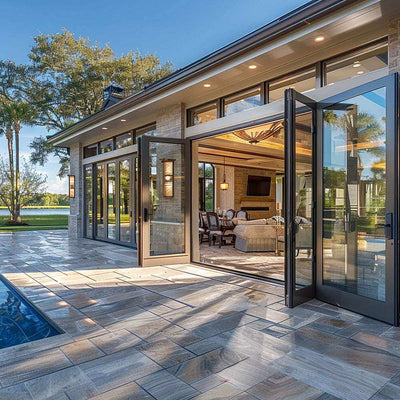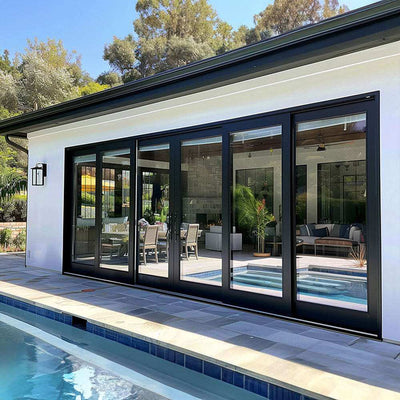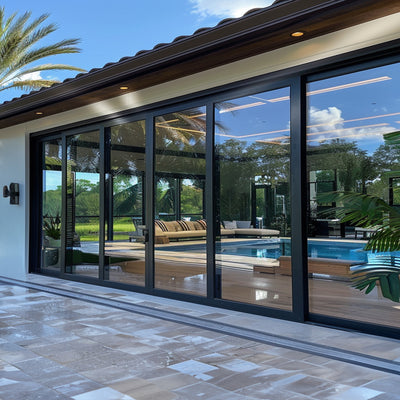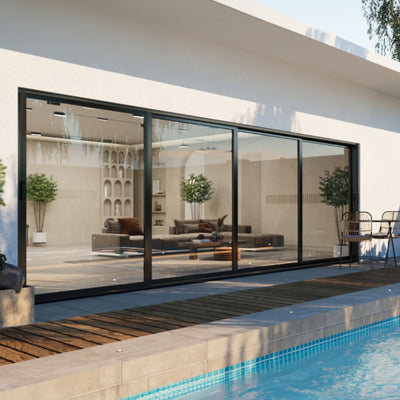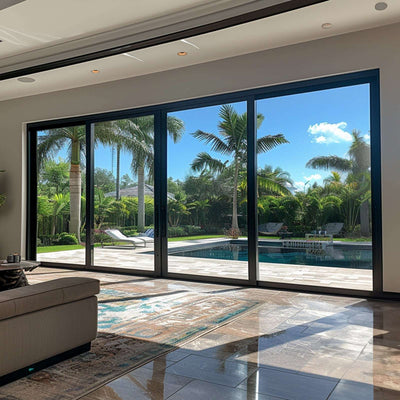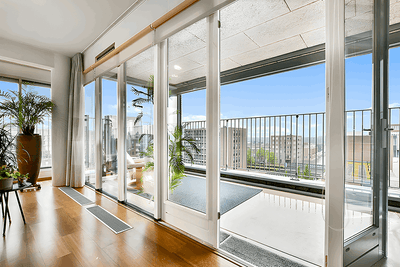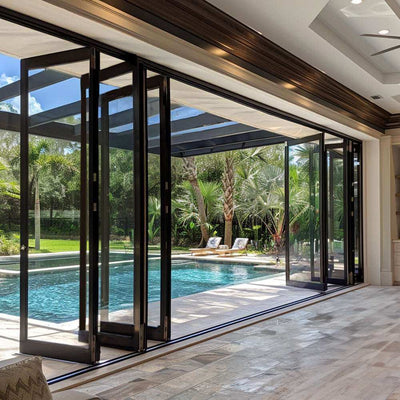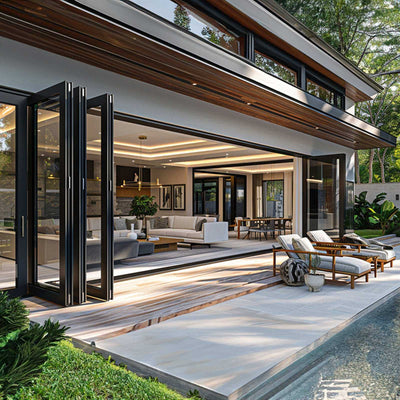Step Inside Style: Reimagine Your Entrance
Your front door is more than just a portal. It's the first impression your home makes, a statement of your personal style, and a reflection of your home's architecture. It's a crucial element in curb appeal. For centuries, front doors have served as both symbolic and functional gateways, evolving from basic wooden barriers to elaborate displays of craftsmanship. Today, they increasingly incorporate technology and sustainable design. Understanding this evolution, from historical significance to modern roles in energy efficiency and security, is key to making informed design choices.
This understanding enhances both the aesthetics and functionality of your property.
In 2025, front door design is experiencing a renaissance, transforming ordinary entrances into striking architectural features. The effectiveness of a modern front door design lies in its ability to seamlessly blend form and function. It should create a welcoming entryway while prioritizing security, energy efficiency, and durability. Whether you're a homeowner aiming to boost curb appeal, a contractor seeking innovative solutions, or a developer envisioning future spaces, staying current with trends is essential.
This article explores the top 10 trends shaping modern front door designs in 2025.
Key Trends Shaping Modern Door Design
- Innovative Materials: We'll delve into the use of cutting-edge materials, from durable composites to striking metals.
- Bold Aesthetics: Discover how color, texture, and architectural details create a captivating first impression.
- Smart Technology: Explore the integration of smart locks, video doorbells, and other tech advancements for enhanced security and convenience. See an example here: Ring Video Doorbell.
- Eco-Conscious Choices: Learn about sustainable materials and energy-efficient designs for environmentally responsible entrances.
Prepare to be inspired and discover how to reimagine your entrance. Create a truly captivating first impression with these design ideas.
1. Pivot Doors
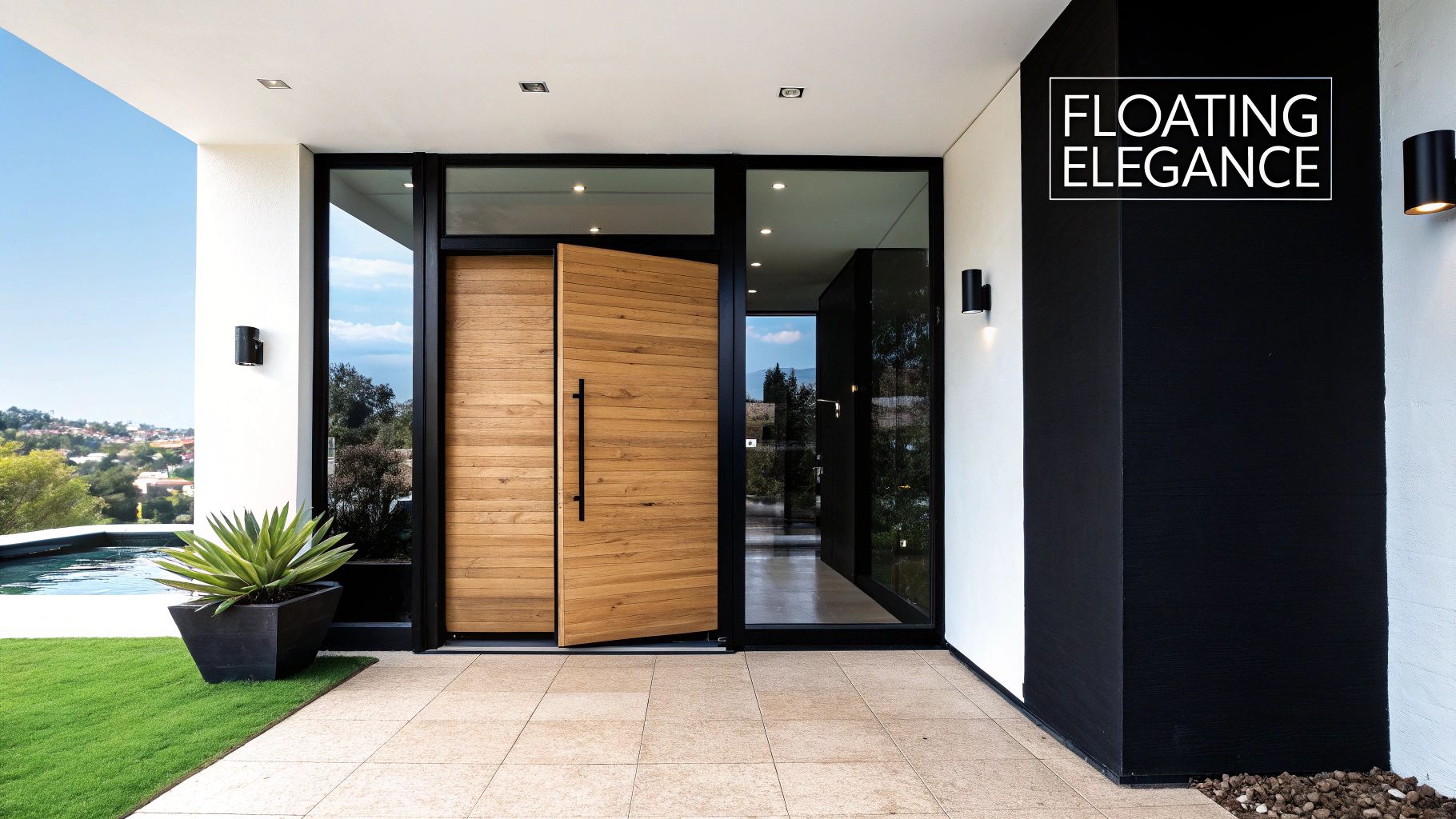
Pivot doors have rapidly become a key feature in modern architecture. They offer a stylish alternative to traditional hinged doors, rotating on a top and bottom pivot mechanism instead of side-mounted hinges. This allows for much larger and heavier door panels, often reaching 8-10 feet high or more. This creates an impressive entrance and a striking focal point.
The ability to accommodate wider panels provides a more expansive opening, improving flow and accessibility. Combined with their smooth, easy operation, pivot doors are a desirable addition to both homes and commercial spaces.
The off-center pivot mechanism allows for unusual opening configurations, adding to the door's visual appeal. This design shifts the door's center of gravity, creating a sense of effortless movement as it opens and closes.
The growing popularity of pivot doors is partly thanks to companies like FritsJurgens, a premium pivot system manufacturer. They popularized sophisticated, high-quality pivot hardware, particularly in luxury homes in Beverly Hills and other high-end locations.
Other key players have further cemented the pivot door's place in modern design. Axon Pivot Doors is known for its installations in Miami beachfront properties, Urban Front specializes in hardwood pivot doors for London townhouses, and Portella crafts steel pivot doors for modern homes in Austin. Architect Charles Gwathmey also played a significant role in bringing these doors into modern residential design.
Features and Benefits
-
Larger and Heavier Construction: Pivot doors support strong materials like solid wood, metal, or glass, allowing for unique design statements.
-
Wider Openings: These doors facilitate better traffic flow and create a grander entrance.
-
Smooth Operation: Despite their weight, pivot doors open and close smoothly and effortlessly.
-
Architectural Focal Point: The unique pivoting action and the possibility of oversized panels create a visually striking entrance.
-
Excellent Weather Sealing (when properly installed): They provide a tight seal against the elements, which is important for energy efficiency and comfort.
Pros and Cons
Pros:
- Creates a dramatic, upscale entrance.
- Supports heavier and more substantial materials.
- Offers a wider opening than traditional doors.
- Provides effective weather sealing.
Cons:
- Considerably more expensive than standard doors.
- Requires professional installation.
- May necessitate structural reinforcement.
- Specialized hardware can be difficult to find.
- Perfect weatherproofing can be challenging and requires meticulous installation.
Tips for Implementation
-
Structural Integrity: Ensure your floor can handle the door's weight. Consult a structural engineer if necessary.
-
Automation: Consider automated systems for easier use and accessibility.
-
Weather Stripping: High-quality weather stripping ensures a good seal to prevent drafts and energy loss.
-
Hardware Selection: Choose specialized pivot hardware designed for the door's specific weight and size.
-
Professional Installation: Budget for professional installation and allow additional time for the process.
Pivot doors have earned their spot on this list by offering a unique and visually impactful design element. They elevate any property's entrance, turning it into a statement piece. While more expensive than traditional doors, the aesthetic impact, functionality, and added architectural value make them a worthwhile investment for those seeking a truly modern and stunning entryway.
2. Steel-Framed Glass Doors
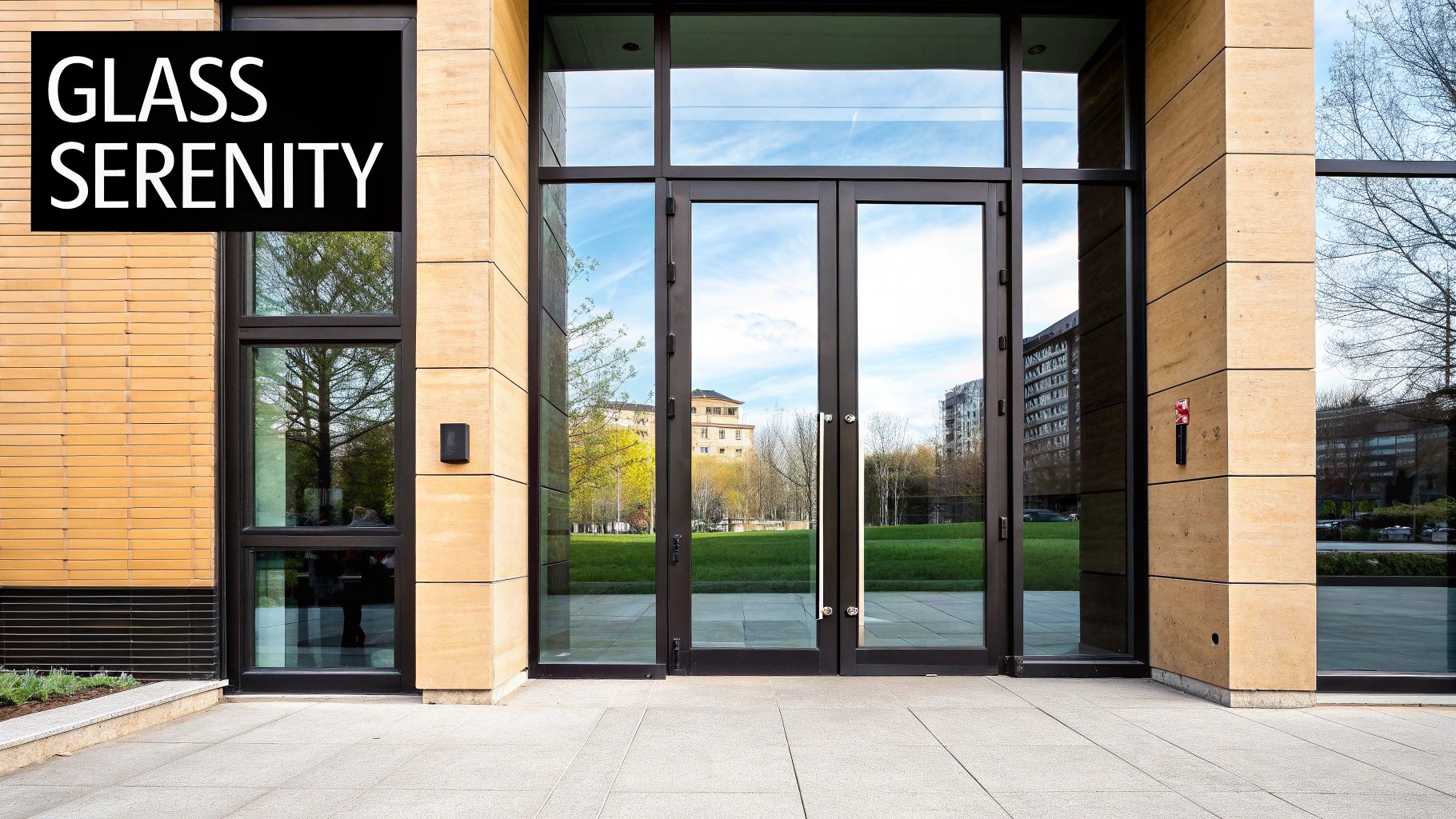
Steel-framed glass doors are giving entryways a modern refresh. With their sleek, industrial look, these doors make a statement. Think slim, powder-coated or raw steel frames surrounding large glass panels, creating a seamless transition between indoors and out. This style has become popular thanks to the growing trend of minimalist design, maximizing natural light, and connecting with the surrounding environment.
The slim steel frames, usually only 1-2 inches wide, maximize the glass area. This allows natural light to flood the entryway, creating a bright and open feel. These large glass panels are often tempered or laminated for safety and durability. Steel's inherent strength offers excellent security and weather resistance, making these doors practical for various climates. Plus, they're highly customizable. You can choose single, double, or even pivot configurations, different grid patterns, and custom sizes to suit any architectural style.
Why Steel-Framed Glass Doors Are Trending
These doors have earned their spot on this list because they perfectly blend form and function. Their timeless aesthetic complements both modern and traditional architecture. Clean lines and an industrial heritage create a sense of sophisticated minimalism. Meanwhile, the robust construction guarantees lasting performance. Imagine Crittal-style doors on renovated brownstones, adding a contemporary touch to historic facades. Crittal Windows is known for its iconic steel window designs. Companies like Portella, Hope's Windows, and Rehme Steel Windows & Doors also showcase the versatility of steel doors in various architectural styles, from modern Texas residences to California modernist homes and luxury properties nationwide.
Pros:
- Maximizes Natural Light: Fills the entryway with daylight for a bright, welcoming space.
- Seamless Indoor-Outdoor Connection: Visually extends the living area and enhances the connection to the outdoors.
- Exceptional Durability and Security: Steel provides superior protection against intruders and weather.
- Timeless Aesthetic: Complements various architectural styles, from traditional to ultra-modern.
- Resistant to Warping: Unlike wood, steel frames maintain their shape and integrity.
Cons:
- Higher Cost: Steel-framed glass doors are generally more expensive than traditional wood or fiberglass doors.
- Potential Energy Efficiency Concerns: Proper glazing with low-E or insulated glass is essential to minimize energy loss.
- Maintenance: Fingerprints and smudges are more noticeable on glass, requiring frequent cleaning.
- Cold to Touch in Winter: Thermal breaks are needed in colder climates to prevent heat transfer.
- Specialized Installation: Requires experienced professionals for correct installation.
Tips for Implementation:
- Consider thermally broken steel frames in extreme climates for better energy efficiency.
- Use low-E or insulated glass to reduce energy costs.
- Choose darker frame colors to hide dirt and fingerprints.
- Apply UV protection film if the door receives direct sunlight.
- Select the right glass thickness for your security needs.
- Regularly lubricate hinges and moving parts.
The popularity of steel-framed glass doors dates back to the early 1900s and the rise of modernism. Architects like Ludwig Mies van der Rohe championed steel and glass, emphasizing clean lines and connection with the environment. Today, these doors continue to be a sought-after feature in modern homes, embodying timeless elegance and industrial charm.
3. Minimalist Flush Doors
Minimalist flush doors are a striking departure from traditional door designs. They emphasize clean lines and blend seamlessly with their surroundings. These doors feature smooth, flat surfaces without panels, moldings, or other raised details. The result is a sleek, contemporary look where the door almost disappears, merging with the wall. This design philosophy makes them ideal for modern homes that prioritize simplicity and understated elegance.
This minimalist approach isn't just about aesthetics. Features like floor-to-ceiling designs (often over the standard 8-foot height), hidden hardware, and integrated or minimalist handles add to the feeling of spaciousness and uninterrupted flow. Precise engineering is essential, ensuring perfect alignment with the wall and a flawless finish. Invisible hinges or pivot systems enhance the clean, uncluttered appearance. High-end versions often conceal all hardware for a truly seamless surface.
The growing popularity of minimalist flush doors reflects a broader trend in minimalist architecture and interior design. This style has been championed by architects like John Pawson and reflected in the work of Tadao Ando. Companies like LUALDI (an Italian minimalist door manufacturer) have been instrumental in promoting this style, featuring their flush doors in luxury Manhattan apartments. Other notable examples include Dayoris Doors' flush systems in Miami's modern homes, TruStile's installations in California tech executive residences, and Bartels' minimalist door systems in European luxury properties. These diverse applications highlight the design's versatility, adaptable to various materials and finishes, including wood, metal, glass, and composites.
While the clean aesthetic and seamless integration with modern interiors are key advantages, there are some factors to consider. Flush doors may lack the character and detail found in traditional homes. Premium versions with concealed hardware can be pricey, and the smooth surfaces can show imperfections more easily than textured doors. Installation often requires specialized expertise for perfect alignment, and these doors may offer less insulation than thicker, traditional doors. For more door options, see our product sitemap.
Tips for Implementing Flush Doors
For those embracing minimalism, here are some practical tips:
- Consider magnetic door stops: These protect walls and maintain clean lines.
- Use concealed closers: These provide smooth, controlled operation with hidden hardware.
- Select high-quality hardware: Even minimalist hardware should be durable and stylish.
- Ensure precise wall alignment during installation: This is crucial for the seamless appearance.
- Choose appropriate acoustic materials for soundproofing: This addresses potential insulation issues.
- Consider soft-close mechanisms: These add a premium touch and prevent slamming.
Minimalist flush doors earn their spot on this list for their ability to transform an entrance into a statement of understated elegance. Their clean lines, seamless design, and focus on functionality embody modern design principles. This makes them a popular choice for those seeking a contemporary aesthetic.
4. Oversized Entry Doors
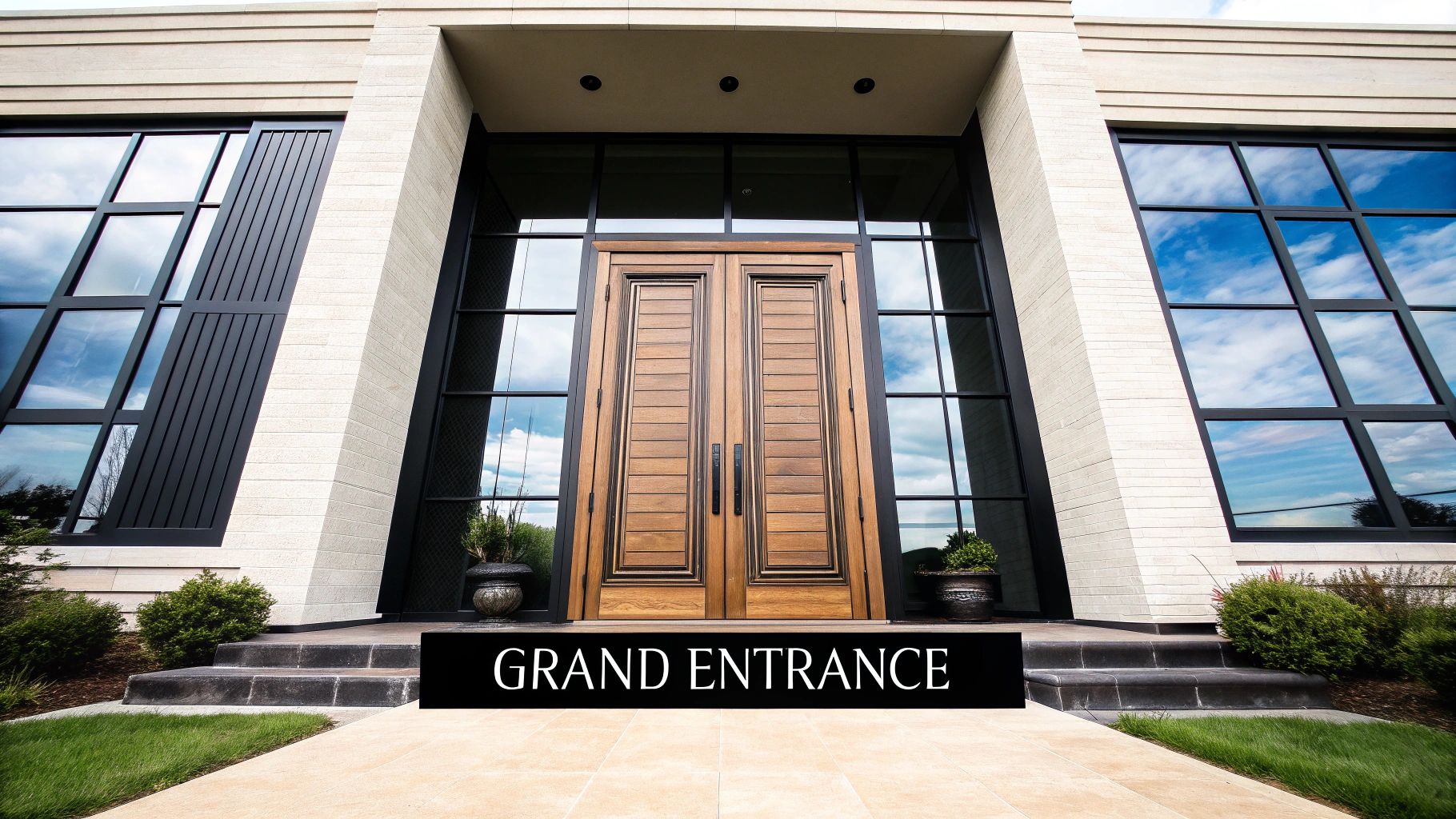
Oversized entry doors are so much more than just a way to get into your house. They make a statement. These impressive entrances, often reaching 8 to 12 feet tall and up to 5 feet wide, instantly boost a home's curb appeal. They create a grand, memorable first impression.
Their sheer size transforms an ordinary entryway into a dramatic focal point. It instantly adds a touch of luxury and elegance.
Materials and Engineering
Modern oversized doors achieve this impact through a combination of high-quality materials and precise engineering. Solid hardwoods, metals, and composites are popular choices, chosen for both their beauty and strength. Because of their weight and size, these doors need strong hardware and reinforced construction. This prevents warping and ensures smooth operation, often using pivot mechanisms instead of traditional hinges.
Benefits Beyond Aesthetics
The benefits of oversized entry doors go beyond just looks. The extra height and width make it easier to move large furniture. It also creates a more welcoming, spacious feeling. Adding glass panels brings in natural light, which enhances the sense of grandeur.
These doors often become a defining architectural feature. This can significantly increase a property's value, creating an image of luxury. Companies like Cantera Doors, known for their 10-foot entries in Austin luxury homes, and Exclusively Doors, with their custom installations in Beverly Hills estates, showcase the high-end appeal of oversized entry doors. BuildDirect's oversized mahogany doors are popular in Florida's luxury properties. Oikos Venezia’s architectural door systems are featured in luxury residences worldwide. Architects like Richard Meier and developers like Mohamed Hadid have further popularized this trend in high-end residential projects.
Practical Considerations
However, it's important to think about the practical aspects. Oversized doors are more expensive than standard doors. They require structural reinforcements to the surrounding walls. Weatherproofing can also be more complex, needing multiple seals to prevent drafts. Installation is a specialized job due to the door's weight and size, often requiring cranes and special equipment.
Custom hardware, while beautiful, can be pricey to replace. The size of these doors can also affect HVAC needs, potentially increasing energy costs. You can explore more door and window options on our product sitemap.
Planning for Oversized Doors
Careful planning is essential if you're considering oversized entry doors. A structural engineering review is crucial before installation. Motorized operation might be necessary for very heavy doors. Commercial-grade hardware designed for heavy use is a must. You'll also need to arrange special delivery and installation logistics. Finally, consider the impact of the door's size on your home's HVAC system when budgeting and designing. By carefully considering these factors, you can ensure your oversized entry door is both a beautiful statement and a functional addition to your home.
5. Natural Wood Slab Doors
For those seeking a front door that seamlessly blends modern aesthetics with natural warmth, a natural wood slab door offers a compelling solution. Crafted from single, solid pieces of timber, these doors are more than just entryways; they're statement pieces that elevate a home's facade. The inherent beauty of the wood grain takes center stage, transforming a natural material into a sleek architectural element.
What distinguishes these doors is their emphasis on the wood's natural characteristics. Book-matched or continuous grain patterns create visual interest, while minimalist hardware allows the wood to remain the focal point. Finishes, whether clear, matte, or oil-based, enhance the natural grain and offer protection.
Often installed vertically, these doors emphasize height and create a sense of grandeur. Custom sizing ensures seamless integration into modern entryways of any dimension. The unique character of each door, told through its distinctive grain patterns, makes it a one-of-a-kind piece.
This inherent individuality brings warmth and organic texture to contemporary architecture. As the wood ages, it develops a rich patina, further deepening its beauty. Beyond aesthetics, solid wood construction provides excellent sound insulation for a more peaceful interior.
Examples of Natural Wood Slab Door Providers
Several companies have embraced this trend:
- Urban Front showcases stunning slab walnut doors in contemporary London homes.
- Architectural Elements features reclaimed teak doors in California residences.
- Hammer & Hand, based in the Pacific Northwest, specializes in custom old-growth installations.
- ADG Doors offers exquisite book-matched wood entries for luxury Florida properties.
The influence of George Nakashima’s philosophy, celebrating natural wood, combined with architect Tadao Ando's minimalist wood applications, has contributed to the growing popularity of this design.
Pros and Cons of Natural Wood Slab Doors
| Pros | Cons |
|---|---|
| Uniquely one-of-a-kind | Requires regular oiling or waxing |
| Natural warmth and organic texture | Climate sensitive (warping/cracking) |
| Develops a beautiful patina over time | Premium wood species can be expensive |
| Provides a quieter interior (sound insulation) | Requires robust hardware and framing |
| Refinishable | Susceptible to sun damage (fading) |
| Blends modern and organic design elements | Vulnerable to moisture (warping/rot) |
Tips for Implementing Natural Wood Slab Doors
- Climate Considerations: Select a wood species appropriate for your environment.
- Stability: Consider engineered cores with veneer for enhanced stability in fluctuating climates.
- UV Protection: Apply UV-resistant finishes for doors exposed to direct sunlight.
- Weather Protection: Install sufficient overhangs.
- Sealing: Apply multiple coats of sealant, especially for exterior use.
- Maintenance: Regularly treat the door with oil or wax.
Natural wood slab doors deserve recognition for their perfect marriage of form and function. They are not just entryways but works of art that enhance any modern home. Careful consideration of wood species, finish, and maintenance ensures homeowners can enjoy their unique beauty for years to come.
6. Metal and Wood Combination Doors
Metal and wood combination doors offer a striking blend of contrasting materials. They combine the warmth and natural beauty of wood with the sleek, strong durability of metal. This creates a sophisticated, modern look that works well in many architectural styles, from contemporary homes to renovated industrial spaces. This unique combination of form and function earns them a place on our list of modern front door designs.
These hybrid doors usually have a metal frame, often made of steel, aluminum, or bronze. This frame provides a solid, stable base. Wood panels or inserts are then added within this framework, bringing a touch of natural beauty and visual flair. The interplay of these materials creates a dynamic look, highlighting the unique qualities of each. Glass elements are also often included, adding to the contemporary feel and letting in more natural light.
Metal and wood combination doors are highly customizable. From industrial-style hardware and details to custom patterns and arrangements of materials, these doors offer a canvas for creative expression. Companies like Axolotl Door are known for their patinated metal and timber doors featured in Australian modernist homes, showcasing this bespoke approach. Semihandmade also creates custom steel and walnut entries in California residences. Amberth uses bronze and oak combinations in London luxury flats, and Riviera Bronze specializes in metal-framed wood doors for coastal properties. Architects like Tom Kundig and designers like Marmol Radziner have also helped popularize this style with their material-focused aesthetics.
Practical Advantages and Challenges
Beyond aesthetics, these doors offer practical benefits. The metal frame provides superior strength and stability, resisting warping and weathering better than a traditional all-wood door. This robust construction also often leads to enhanced security. Metal's durability, combined with wood's insulating properties, makes these doors suitable for various climates. Check out Our Gladiator Window & Door Collections Sitemap for more door options.
However, there are some challenges. Manufacturing these hybrid doors is more complex, resulting in a higher cost. Careful design and construction are essential to account for the different expansion rates of wood and metal, preventing warping or cracking. Repairs can also be more complex, requiring specialized skills. While the metal frame is durable, the wood still needs regular maintenance. The weight of these doors, especially with heavier metals and hardwoods, should also be considered during planning and installation.
Pros:
- Combines the strengths of metal (strength, stability, security) and wood (warmth, beauty).
- More stable and less prone to warping than all-wood doors.
- Distinctive contemporary aesthetic.
- Often offers better security.
- Allows for creative expression through material contrast.
- Generally more durable in varied climates.
Cons:
- Higher cost due to complex manufacturing.
- Requires careful design to manage material expansion differences.
- More challenging repairs.
- Limited standardization requires custom solutions.
- Wood portions require regular maintenance.
- Can be very heavy depending on materials.
Tips for Implementation:
- Consider thermal breaks between materials in extreme climates.
- Choose compatible finishes that complement both materials.
- Plan for different expansion rates during construction.
- Select wood species based on weather exposure.
- Use high-quality hardware designed for hybrid doors.
- Consider how the materials will age together over time.
7. Sculptural 3D Doors
Sculptural 3D doors are redefining the very idea of a home's entrance. They're no longer just a way to get inside; they're captivating works of art. These doors move beyond the flat and ordinary, embracing depth, texture, and the fascinating interplay of light and shadow. Through dimensional surface treatments, geometric or organic patterns, and custom relief work, they introduce a dynamic element that shifts and changes throughout the day. Each sculptural door is typically a custom creation, serving as both a practical entryway and a unique piece of architectural art, often becoming the defining feature of a home's exterior.
These doors have earned a spot on this list due to their unparalleled level of customization and artistic expression. They are more than just doors; they are functional sculptures that significantly boost a home's curb appeal and reflect the homeowner's individual style. Features like CNC-milled relief designs, asymmetrical compositions, and the strategic use of mixed materials create textural contrasts and captivating visual interest.
The Rise of Sculptural Doors
The increasing popularity of sculptural 3D doors can be attributed to several factors. The growing accessibility of CNC milling technology, for example, allows for intricate designs to be created with incredible precision. The influence of parametric design, championed by architects like Zaha Hadid, has also played a role. The dimensional approach to surfaces by designers like Marcel Wanders has further paved the way for wider acceptance of this dynamic aesthetic.
Companies like Foret Design Studio, known for their algorithmic 3D doors in San Francisco tech executive homes, and Semihandmade, with their CNC-carved doors in Los Angeles modernist homes, are leading this trend. Borano's custom relief doors grace luxury properties in Miami, while SplinterWorks creates commissioned door sculptures for international luxury residences.
Pros:
- Creates a truly unique, signature entrance
- Serves as functional architectural art
- Changes appearance throughout the day with shifting light
- Makes a powerful design statement
- Can be tailored to reflect architectural themes or personal tastes
- Often becomes a conversation piece
Cons:
- Significantly higher cost due to custom design and fabrication
- More challenging to clean and maintain complex surfaces
- May trap dust and debris in recesses
- Can limit hardware placement options
- Often requires specialized fabrication techniques
- May be difficult to repair if damaged
Tips for Implementation:
- Light and Shadow: Carefully consider how the design will interact with changing light conditions throughout the day.
- Visualization: Use 3D modeling software like Blender to visualize the final result and ensure the design aligns with your vision before fabrication.
- Functionality: Ensure the sculptural elements don't interfere with the door's functionality (opening, closing, and hardware placement).
- Lighting: Plan for appropriate lighting to highlight the door's dimensions, both day and night.
- Durability: Choose durable materials that can withstand the elements and maintain their appearance.
- Integration: Consider how the door will integrate with the surrounding architecture and landscape.
Sculptural 3D doors represent a significant advancement in front door design. They offer a powerful way to make a statement and personalize a home's exterior. While the investment is considerable, the resulting artistic impact and unique curb appeal are truly remarkable.
8. Smart Security Entry Systems
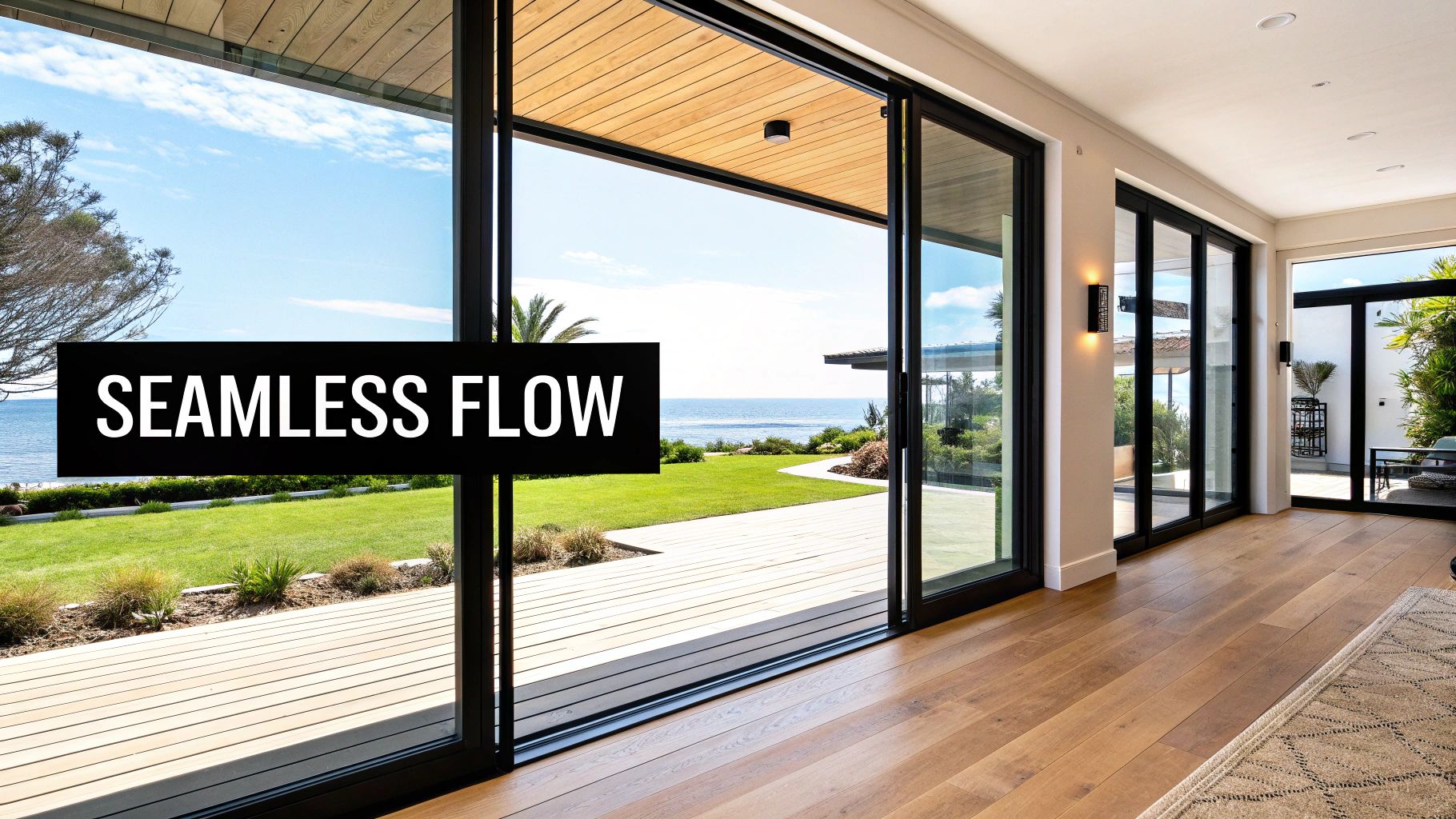
Smart security entry systems offer a modern take on front door security, combining advanced technology with sleek design. These systems transform your entryway into a smart hub, offering keyless entry through options like biometrics (fingerprint scanning, facial recognition, iris scanning), digital keypads, and smartphone app control. All this is achieved while maintaining the clean lines of contemporary design. This integration of access control boosts both the security and convenience of your home.
The rise of smart locks started with homeowners looking for improved security and remote access. Companies like August Home pioneered the concept of keyless entry and remote management. Today, industry leaders like Yale Smart Living, Kwikset, Latch, HAVEN Connect, Level Lock, and SimpliSafe have expanded the market with diverse solutions for different needs and budgets.
Examples of Smart Lock Adoption
- Latch: Prominent in upscale multi-family buildings in New York.
- HAVEN Connect: Integrates smart locks into modern Texas homes.
- Kwikset's Obsidian: A popular choice among California tech executives.
- Yale Assure Lock SL: Seamlessly integrates into minimalist residences.
The advantages of smart security systems are many. Eliminating physical keys offers greater convenience and reduces the risk of lockouts. Features like activity logs, remote locking/unlocking, and temporary access codes for guests provide enhanced control and peace of mind. Integration with home automation systems allows for automated features and bolsters security through multiple authentication factors. You can explore more on integrating various home systems on our blog sitemap.
However, potential downsides should be considered. Smart locks generally cost more upfront than traditional locks. They require a power source or battery upkeep, and there's a possibility of technical malfunctions. Professional installation might be necessary, and privacy concerns exist with cloud-connected systems. Sophisticated hacking attempts are a risk, and technology can eventually become obsolete.
Tips for a Secure Smart Lock Experience
- Backup Access: Establish backup access methods for power or system failures.
- Weatherproofing: Prioritize weatherproof ratings for exterior installations.
- Future Updates: Plan for firmware updates and technology advancements.
- Encryption: Choose systems with robust end-to-end encryption.
- Design: Select designs that complement your home's architecture.
- Compatibility: Verify compatibility with current home automation platforms.
- Professional Monitoring: Consider professional monitoring services for added security.
Smart security entry systems deserve their spot on the list of modern front door designs. They combine enhanced security and convenient access control with a sleek, modern aesthetic, making them an attractive solution for homeowners and builders seeking intelligent, secure, and stylish homes.
9. Indoor-Outdoor Flow Doors
Indoor-outdoor flow doors are changing the way we experience our homes. These innovative entry systems blur the lines between interior and exterior spaces, creating a seamless transition that expands living areas and brings the outdoors in. They’re not just about entry and exit anymore; they're about enhancing lifestyle and boosting property value.
This connection is achieved through large glass panels, often stretching across entire walls, with minimal framing for unobstructed views. Flush thresholds create a smooth transition between indoor and outdoor flooring, adding to the sense of continuity. The doors themselves operate in various ways, including sliding, folding, and stacking, offering flexibility for various needs and spaces. Precise engineering ensures these systems operate smoothly despite their substantial size and weight.
Features and Benefits
- Expansive Glass Panels: Maximize natural light and uninterrupted views, visually extending the interior.
- Minimal Framing: Enhances the seamless transition and maximizes glass for a dramatic effect.
- Flush Thresholds: Eliminate tripping hazards and create seamless flow between inside and out.
- Multiple Operational Modes: Sliding, folding, and stacking options offer flexibility.
- Weather-sealing: Maintains climate control and energy efficiency.
- High-Performance Glazing: Options like Low-E coatings manage energy transfer and enhance insulation.
Pros and Cons
Pros:
- Enhanced Connection to Nature: Creates a strong connection to outdoor spaces, boosting well-being.
- Maximized Natural Light: Floods interiors with natural light, reducing the need for artificial lighting.
- Extended Living Area: Seamlessly connects indoor and outdoor spaces, expanding the functional living area.
- Flexibility for Different Weather Conditions: Adaptable use of space, open for fresh air or closed for protection.
- Architectural Drama and Spatial Flow: Enhances the architectural aesthetic and creates a sense of spaciousness.
- Increased Property Value: Adds significant value to homes.
Cons:
- Premium Cost: Typically more expensive than standard doors due to their complexity.
- Energy Efficiency Challenges: Large glass areas can pose challenges for energy efficiency.
- Precision Installation: Requires precise installation by experienced professionals.
- Maintenance: Tracks and mechanisms require regular maintenance.
- Security Concerns: Requires careful selection of glazing and locking mechanisms.
Real-World Examples and Evolution
The idea of blurring indoor-outdoor boundaries has roots in mid-century modern architecture, notably the work of architects like Richard Neutra. Designers like Marmol Radziner further popularized this concept. Companies like NanaWall Systems, LaCantina Doors, Fleetwood Windows & Doors, and Western Window Systems have advanced the technology. Examples include NanaWall's folding glass systems, LaCantina's multi-slide doors, and Fleetwood's pocket sliding doors.
Tips for Implementation
- Energy-Efficient Glazing: Consider Low-E glass.
- Drainage: Ensure proper drainage to prevent water intrusion.
- Insect Screens: Plan for insect screens.
- Door Operators: Use appropriate operators for large systems.
- Locking Mechanisms: Select appropriate locking mechanisms.
- Motorization: Consider motorization for large systems.
- Maintenance: Plan for regular track system maintenance.
By considering the features, benefits, and challenges, and following these tips, homeowners can integrate indoor-outdoor flow doors into their projects, creating exceptional living spaces.
10. Sustainable and Eco-Friendly Doors
Sustainable and eco-friendly doors are becoming increasingly popular. They represent a growing trend where modern design meets environmental responsibility. This approach to entry systems prioritizes recycled, reclaimed, or rapidly renewable materials. It also incorporates energy-efficient features and non-toxic finishes. Beyond the obvious environmental benefits, these doors often bring unique character and charm to a home. They might showcase the authentic patina of reclaimed woods or the distinctive qualities of alternative materials like bamboo. This blend of sustainability and design makes them an appealing choice for environmentally conscious homeowners.
One key feature driving the popularity of eco-friendly doors is the use of reclaimed or FSC-certified woods. Companies like Pioneer Millworks are known for their stunning conversions of historic timbers into beautiful entryways. They've done particularly impressive work in Pacific Northwest eco-homes. The use of rapidly renewable materials like bamboo and cork offers further sustainable choices. Bamboo Living is a great example of this, with their sustainable bamboo entry systems used in tropical modern architecture. The commitment to minimizing environmental impact is also reflected in the incorporation of recycled metal components, high-performance insulation cores, and low-VOC or natural finishes. If the door incorporates glass, energy-efficient glazing contributes to the overall energy performance of the building envelope.
The benefits of choosing a sustainable front door go beyond environmental stewardship. These doors often offer unique aesthetic character that you won’t find in mass-produced options. Reclaimed materials, in particular, bring a history and texture that add significant visual interest. Furthermore, using non-toxic materials contributes to healthier indoor air quality, a growing concern for many homeowners.
From a practical standpoint, these doors improve your home's energy efficiency, potentially lowering utility bills and increasing comfort. They can also contribute to achieving green building certifications, adding value to your property. Check out our article about Gladiator Sitemap for more information about building materials and their impacts.
However, there are some factors to consider. Eco-friendly doors can sometimes be more expensive than conventional options because of specialized sourcing and craftsmanship. The availability of certain sustainable materials can also be limited, which may lead to longer lead times.
Some eco-materials may have different durability profiles compared to traditional materials, and their maintenance requirements can vary. It's essential to understand these nuances before making a decision.
Architects like Michelle Kaufmann, known for her sustainable prefab designs, have helped popularize this movement. The “Not So Big House” philosophy championed by designer Sarah Susanka has also contributed. Companies like Klearwall, with their Passive House certified entry doors featured in Northeast sustainable homes, and Eco Supply Center, offering reclaimed barn wood doors perfect for modern farmhouse designs, further demonstrate the diverse applications of this concept.
To make a truly sustainable choice, verify the certification credentials for materials. Consider the full lifecycle impact of the door, from sourcing to disposal. Evaluate the long-term durability of alternative materials and select finishes that maintain your eco-focus. Balancing thermal performance with your sustainable material choices is also key. Finally, researching local sources can reduce transportation impacts. Considering the end-of-life recyclability or biodegradability of the door contributes to a truly circular economy.
Modern Front Door Designs: 10-Point Comparison
| Design Idea | Implementation Complexity 🔄 | Resource Requirements ⚡ | Expected Outcomes 📊 | Ideal Use Cases 💡 | Key Advantages ⭐ |
|---|---|---|---|---|---|
| Pivot Doors | High – requires structural reinforcement and expert install | High – heavy materials and specialized hardware | Dramatic visual appeal with smooth, expansive openings | Luxury residences and modern architectural statements | Creates a striking, high-end entrance |
| Steel-Framed Glass Doors | Moderate-High – specialized installation and precision work | Moderate-High – premium metal and large glass panels | Maximizes natural light; refined minimalist aesthetic | Urban modern homes, offices, and contemporary settings | Balances industrial appeal with elegant design |
| Minimalist Flush Doors | Moderate – precision engineering with concealed systems | Moderate – quality, flat finishes and hidden hardware | Clean, uncluttered and seamlessly integrated entryway | Contemporary interiors and minimalist designs | Offers pure, uninterrupted modern elegance |
| Oversized Entry Doors | High – demands heavy-duty hardware and structural review | High – custom-engineered, premium materials | Grand dramatic impact with luxury presence | Upscale properties and grand architectural statements | Creates an immediate, bold architectural statement |
| Natural Wood Slab Doors | Moderate – requires careful material selection and upkeep | Moderate – quality natural wood with unique grain patterns | Unique, warm, organic aesthetic that evolves with time | Modern designs emphasizing natural elements and texture | Showcases distinctive wood character and patina |
| Metal and Wood Combination Doors | High – integration of contrasting materials demands precision | High – combines premium metals and quality woods | Distinctive hybrid aesthetic with enhanced durability | Contemporary residences seeking both strength and warmth | Merges the best of both materials effectively |
| Sculptural 3D Doors | Very High – custom fabrication and artistic detailing | Very High – complex design with bespoke manufacturing | Transforms entryways into dynamic, signature art pieces | Iconic or luxury custom homes and architectural landmarks | Elevates functionality into artistic expression |
| Smart Security Entry Systems | Moderate – integration of advanced tech with design integrity | Moderate – high-tech components and secure materials | Enhanced security, convenience, and remote access control | High-security residences, modern offices, and smart homes | Seamlessly integrates technology with modern design |
| Indoor-Outdoor Flow Doors | High – requires precision engineering and complex mechanisms | High – premium glass, minimal frames, and robust hardware | Creates seamless indoor-outdoor transitions with abundant light | Open-concept homes and spaces aiming for fluid spatial connectivity | Blurs boundaries with a modern, expansive feel |
| Sustainable and Eco-Friendly Doors | Moderate – challenges in sourcing certified, green materials | Moderate-High – eco-certified, renewable or recycled inputs | Improved energy efficiency with reduced environmental impact | Green buildings and eco-conscious design projects | Combines sustainability with innovative design |
Elevate Your Entrance: Choosing the Perfect Modern Door
From pivot doors that make a grand statement to sustainable options that minimize environmental impact, the world of modern front door design offers a diverse range of choices. Choosing the right door involves careful consideration of several factors. Your home's architectural style should guide your decision. A sleek, minimalist door complements a modern home, while a natural wood slab door might be more fitting for a rustic or craftsman aesthetic.
Budget is another key factor. Material and size significantly influence cost. Finally, prioritize desired features. These could include smart locks, integrated lighting, or enhanced energy efficiency.
Planning Your Perfect Entrance
Putting these concepts into practice involves research and planning. Browse online resources and magazines for inspiration. Visiting showrooms lets you experience different door styles firsthand. Consulting with architects or contractors provides professional guidance.
Don't hesitate to experiment with different combinations of materials, finishes, and hardware. This allows you to achieve a unique and personalized look.
The Future of Door Design
The world of door design is constantly evolving. Smart home integration, sustainable materials, and customizable features are prominent trends shaping the future of entryways. Staying informed about these developments helps you make sound decisions. It also ensures your chosen door remains contemporary for years to come.
Key Takeaways:
- Harmony with Architecture: Select a door that complements your home's style.
- Budgetary Considerations: Balance aesthetics with affordability.
- Prioritize Functionality: Choose features that enhance security, energy efficiency, and convenience.
- Embrace Innovation: Keep up-to-date on the latest trends and technologies.
Ready to transform your entrance and boost your home's curb appeal? Gladiator Window and Doors offers a premium selection of modern door designs. These include extra-large sliding, pivot, bi-fold, and panoramic options, all at the lowest prices in the USA. Our custom-made, thermally rated, and USA-approved doors provide unmatched quality and performance, backed by the best warranty in the industry. Get massive doors at a fraction of the cost and experience the Gladiator difference. Visit us today at Gladiator Window and Doors to explore our extensive collection and discover the perfect modern door for your home.

















